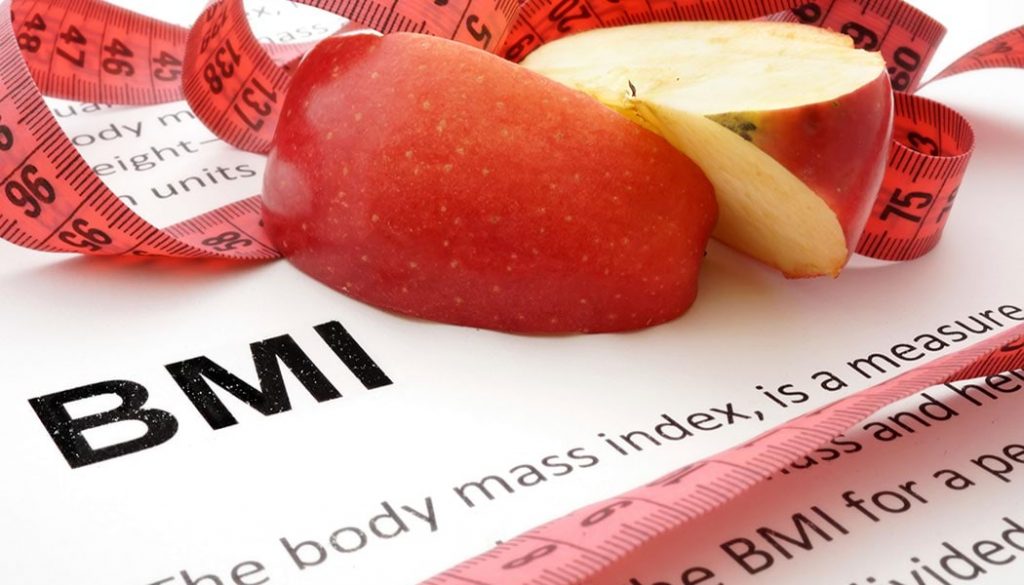
It is normal for your body to store energy as fat. However, too much or too little body fat can increase your risk of illness and disease, depending on where your body stores it.
The amount of fat your body has stored can be accurately measured with a dual-energy absorptiometry (or DXA) machine. This is known as having a DXA scan. A much cheaper alternative is to estimate your total amount of body fat by calculating your body mass index (BMI).
BMI is a useful indicator of health at the population level. However, the distribution of fat on your body is more important that the amount, when assessing your disease risk. For this reason, your waist circumference is thought to be a better predictor of health risk than your BMI.
Increased abdominal obesity is related to a higher risk of cardiovascular disease, type 2 diabetes and cancer. Abdominal obesity is measured using waist circumference.
Body mass index (BMI)
Body mass index (BMI) is an approximate measure of your best weight for health. It is calculated by dividing your weight in kilograms by your height in metres squared (m2).
BMI is intended for adults only, as children and adolescents are constantly growing. This makes it difficult to have set values for BMI cut-offs for young people. However, in adults who have stopped growing, an increase in BMI is usually caused by an increase in body fat.
You can use the body mass index (BMI) calculator for adults to calculate your BMI, provided you know your:
- weight in kilograms (kg)
- height in centimetres (cm).
Your BMI will classify you as ‘underweight’, ‘healthy weight’, ‘overweight’ or ‘obese’, as defined by the World Health Organization. If your BMI is:
- under 18.5kg/m2 – you are considered underweight and possibly malnourished
- 18.5 to 24.9kg/m2 – you are within a healthy weight range for young and middle-aged adults
- 25.0 to 29.9kg/m2 – you are considered overweight
- over 30kg/m2 – you are considered obese.
For older Australians over the age of 70 years, general health status may be more important than being mildly overweight. Some researchers have suggested that a BMI range of 22–26 kg/m2 is desirable for older Australians.
BMI isn’t always the best measure of health
At the population level, BMI is used to indicate level of risk for morbidity (disease risk) and mortality (death rates).
Differences in BMI between individual adults of the same age and sex are usually due to body fat, however there are many exceptions to this rule, which is why a BMI figure may not always be accurate.
BMI calculations will overestimate the amount of body fat for:
- body builders
- some high-performance athletes
- pregnant women.
BMI calculations will underestimate the amount of body fat for:
- the elderly
- people with a physical disability, who are unable to walk and may have muscle wasting.
BMI is also not an accurate indicator for people with:
- eating disorders like anorexia nervosa
- extreme obesity.
Why isn’t BMI always the best measure of health?
Generally speaking, the more body fat you’re carrying, the higher your health risk. However, BMI cannot differentiate between body fat and muscle mass.
This means there are some exceptions to the BMI guidelines:
- Muscles – body builders and people who have a lot of muscle bulk will have a high BMI, but are not overweight.
- Physical disabilities – people who have a physical disability and are unable to walk may have muscle wasting. Their BMI may be slightly lower, but this does not necessarily mean they are underweight. In these instances, it is important to consult a dietitian who will provide helpful advice.
- Height – BMI is not totally independent of height and it tends to overestimate obesity among shorter people and underestimate it among taller people. Therefore, BMI should not be used as a guide for adults who are very short (less than 150 cm) or very tall (more than 190 cm).
- People of different ethnic groups – Asians and Indians, for example, have more body fat at any given BMI compared to people of European descent. Therefore, the cut-offs for overweight and obesity may need to be lower for these populations. This is because an increased risk of diabetes and cardiovascular disease begins at a BMI as low as 23kg/m2 in Asian populations. Some populations have equivalent risks at a higher BMI, such as people of Torres Strait Islander and Maori origin.
What is a healthy BMI range for children?
BMI calculations used for adults are not a suitable measure of weight for children or adolescents. BMI calculations for children and adolescents are interpreted differently from an adult’s and take into account the age and sex of the child or adolescent.
The current BMI charts for children have been developed by the US Centres for Disease Control and Prevention. They are useful for the assessment of overweight and obesity in children aged over two years.
To calculate a child’s BMI, you can use the body mass index calculator for children and teenagers.
However, BMI charts should be used only as a guide to indicate when to make small lifestyle changes, and when to seek further guidance from a doctor or a dietitian.
Being overweight or underweight can affect your health
The link between being overweight or obese and the chance you will become ill is not definite. Research is ongoing.
Statistically, there is a greater chance of developing various diseases if you are overweight. For example, the risk of death rises by 20 to 30 per cent as BMI rises from 25 to 27kg/m2. As BMI rises above 27 kg/m2, the risk of death rises more steeply (by 60 per cent).
Risks of being overweight (high BMI) and physically inactive
If you are overweight (with a BMI over 25kg/m2) and physically inactive, you may develop:
- cardiovascular (heart and blood circulation) disease
- gallbladder disease
- high blood pressure (hypertension)
- type 2 diabetes
- osteoarthritis
- certain types of cancer, such as colon and breast cancer
- depression and other mental health disorders.
Risks of being underweight (low BMI)
If you are underweight (BMI less than 18.5kg/m2), you may be malnourished and develop:
- compromised immune function
- respiratory disease
- digestive diseases
- cancer
- osteoporosis.
Waist circumference is a better indicator of increased disease risk
A person’s waist circumference is a better predictor of health risk than BMI. When identifying health risk in adults, it is recommended that you combine your BMI classification with your waist circumference as a measurement of disease risk.
Having fat around the abdomen or a ‘pot belly’, regardless of your body size, means you are more likely to develop certain obesity-related health conditions.
Fat predominantly deposited around the hips and buttocks doesn’t appear to have the same health risk. Men, in particular, often deposit weight in the waist region and therefore have an increased risk of obesity-related disease.
Studies have shown that the distribution of body fat is linked to an increased prevalence of diabetes, hypertension, high cholesterol and cardiovascular disease.
Generally, the associations between health risks and body fat distribution are:
- least risk – slim (evenly distributed body fat)
- moderate risk – overweight with no pot belly
- moderate to high risk – slim with pot belly
- high risk – overweight with excess belly fat.
Waist circumference and health risks
Waist circumference can be used to indicate health risk for chronic diseases.
For men:
- 94 cm or more – increased risk
- 102 cm or more – substantially increased risk.
For women:
- 80 cm or more – increased risk
- 88 cm or more – substantially increased risk.
Although the tendency to deposit fat around the middle is influenced by a person’s genes, you can still take this genetic tendency into account and do something about it.
Being physically active, avoiding smoking, and eating unsaturated fat instead of saturated fat have been shown to decrease the risk of developing abdominal obesity.




